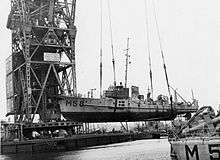Operation Safari
| Operation Safari Unternehmen Safari | |||||||
|---|---|---|---|---|---|---|---|
| Part of the Occupation of Denmark | |||||||
 Danish officers being detained on 29 August 1943 | |||||||
| |||||||
| Belligerents | |||||||
|
|
| ||||||
| Commanders and leaders | |||||||
|
Hermann von Hanneken Hans-Heinrich Wurmbach |
Aage H. Vedel Ebbe Gørtz | ||||||
| Strength | |||||||
|
1 mine warfare vessel 2 torpedo boats |
2,200 soldiers[1] 1,100 auxiliary troops 4,300 sailors 2 Coastal defence ships 10 torpedo boats 7 minelayers 18 minesweepers 2 floating workshops 12 submarines 4 large patrol ships 2 survey ships 2 station vessels 1 Royal yacht 59 patrol cutters 1 transport ship | ||||||
| Casualties and losses | |||||||
|
1–11 killed[1][2] 8–59 wounded[1][3][2] At least 1 aircraft damaged |
23–26 killed, 40–50 wounded[4] 1 coastal defence ship grounded 1 coastal defence ship scuttled 4 torpedo boats scuttled 1 torpedo boat blown up 4 torpedo boats captured 7 minelayers scuttled 6 minesweepers scuttled 9 minesweepers captured 1 floating workshop torched 1 floating workshop captured 9 submarines scuttled 3 submarines captured 1 large patrol ship scuttled 3 large patrol ships captured 1 survey ship partly destroyed 1 survey ship captured 2 station vessels captured 50 patrol cutters captured 1 transport ship captured | ||||||
Operation Safari (German: Unternehmen Safari) was a German military operation during World War II involving 9,000 German soldiers.[5] Launched with the intention of disarming the Danish military, it led to the scuttling of the Royal Danish Navy, and internment of all Danish soldiers. On the Danish side it resulted in 23–26 dead, and around 40–50 injured.[1] A total of 4,600 Danish personnel were captured.[6] German losses were reported as one killed and eight wounded,[2] although they may have been as high as 11 killed and 59 wounded.[1][3]
Background
.jpg)
During the early years of the war, Denmark had been known as the model protectorate, earning the nickname the Cream Front (German: Sahnefront), due to the relative ease of the occupation and copious amount of dairy products.[7]
General Hermann von Hanneken, the head of German land forces in Denmark, had wanted the Danish Army to be disarmed; if the Allies landed in the country, Danish forces could interfere with German supplies and communications. Plans to disarm the Danish Army were initially drafted in June 1943 and by July they were nearly ready. Vice Admiral Hans-Heinrich Wurmbach, Germany's top naval officer in the region, was opposed to moving against the Danish Navy. He thought that the Danes were cooperating well and as long as the Danish Navy was active it held a wide array of maritime responsibilities that would otherwise cost the German Navy resources and manpower.[8] However, the situation in Denmark had deteriorated over the summer. On 28 July a Danish worker bombed a German freighter at the Odense shipyard. Tensions between the Germans—who had wanted to guard the ship—and Danish labourers increased, culminating in the "August uprising"; by the end of August both German and Danish authorities were unable to control the civil unrest in many cities across the country.[9] The Germans resolved at a late stage to disarm the Danish Navy; Wurmbach was unable to inform his subordinates of the operation until 16 August. Planning lasted until 26 August.[8]
The Germans declared Denmark "enemy territory" on 28 August.[10][5] That day the Danish government was removed from power, von Hanneken's plan was initiated, and martial law was imposed in Denmark.[5]
Operation
The objective of the operation was to simultaneously capture and disarm the Danish forces, in order to prevent them from assisting a possible Allied invasion.[6]
Army
The army was caught relatively off guard, which led to sporadic resistance. The operation started at 04:00 and saw action taking place at every army installation in the country. At many places the soldiers surrendered peacefully, but at others there was heavy fighting. At the barracks in Næstved, where future Prime Minister Anker Jørgensen was stationed, two Danish soldiers lost their lives.[11] When German forces tried to access the armoury at the Shooting School for Handguns, a firefight broke out which resulted in three Germans being killed.[12][13] The royal family, was staying at Sorgenfri Palace when the Germans, under the command of Lieutenant General Eduard Ritter von Schleich, attacked the palace, resulting in a firefight and the death of seven Germans.[3]
Navy

Following an incident, where the navy were forced to give six torpedo-boats to the Germans, the navy had started planning for an eventual scuttling on 5 February 1941.[14][15]
At 04:08, the message (K N U) was sent from the Danish Naval High Command, warning their crews that the German operation was about to begin. The first explosion occurred at 04:13 as, in anticipation of the German operation, the navy scuttled their ships in harbour, while those ships that were already at sea tried to escape to neutral or Allied waters. One such vessel was Niels Juel. The vessel was intercepted and this led to the Battle of Isefjord.[16]
Following their capture most naval personnel were interned at KB Hallen.[17]
Of the fifty-two vessels[18] in the Danish Navy on 29 August, two were in Greenland, thirty-two were scuttled, four reached Sweden and fourteen were taken undamaged by the Germans. Nine Danish sailors lost their lives and ten were wounded.[19][20][21]
Bases and facilities that were attacked
The following bases and facilities were attacked:[22]
- Hærens Geværfabrik/Ny Tøjhus
- Ammunitionsarsenalet
- Amager Barracks
- Bådsmandsstrædes Barracks
- Herluf Trollesgades Barracks
- Skydeskolen for Håndvåben
- Gernersgades Barracks
- Rosenborg Barracks
- Jægersborg Barracks
- Gardehusarkasernen i Næstved
- Odense Kaserne
- Nyborg Kaserne
- Gernersgades Barracks
- Sorgenfri Palace[3]
- Holmen, Copenhagen
- Kongelundsfortet
- Middelgrundsfortet
- Flådestation Korsør
- Flådestation Nyborg
Aftermath

As a result of the operation a total of 4,600 Danish personnel were captured, although some were later able to escape.[6] In addition, between 23 and 26 Danish personnel were killed and another 40 to 50 were injured.[1] The Danes were able to scuttle 32 vessels, while between six and 13 escaped, and 14 were captured by the Germans.[6][19][20] The Germans reported their own losses as one killed and eight wounded,[2] although they may have been as high as 11 killed and 59 wounded.[1][3]
– Commander Paul Ipsen, Head of the Danish Coastal Forces[23]
Without the Danish Government and armed forces, the Germans were now in control of Denmark and its internal affairs. The German authorities could now focus on the Jewish question, leading to the deportation and eventual rescue of the Danish Jews.[24] Vice Admiral Vedel continued his service as Director of the Ministry of the Navy in the permanent secretaries' administration until liberation in 1945.[25]
It led to the creation of the Small General Staff, a resistance movement composed of officers, with the aim of intelligence gathering. The soldiers that escaped to Sweden created the Danish Brigade in Exile, where they trained until the end of the war, when they returned to fight during the liberation. The ships that managed to escape became a part of the Danish Flotilla, while the Germans managed to raise many of the ships sunk. The Germans also captured Horserød camp, where Danish communists were held. Approximately 150 of these were sent to Stutthof concentration camp in Germany.[5]
Legacy

On 29 August 2003, Danish Prime Minister Anders Fogh Rasmussen delivered a speech before staff and students of the Royal Danish Naval Academy. He praised the scuttling of the navy and the resignation of the government during Operation Safari, asserting that the actions elevated the Allies' opinions of Denmark.[26]
See also
Citations
- 1 2 3 4 5 6 7 "Hvad var det, der skete den 29. august 1943 tidligt om morgenen?" [What was it that happened on 29 August 1943 early in the morning?] (in Danish). Danish Armed Forces. 29 August 2003. Archived from the original on 27 September 2007.
- 1 2 3 4 "Blev der skudt mod de indtrængende tyskere på Holmen den 29. august 1943?" [Was there a shot against the invading Germans on Holmen on August 29, 1943?]. Dansk Militaerhistorie (in Danish). Retrieved 19 December 2017.
- 1 2 3 4 5 Otzen, Theis (21 April 2015). "The Germans Attacked Sorgenfri Palace". Gentofte Lokalavisen (in Danish). Retrieved 23 December 2017.
- ↑ Thomas, Nigel. Hitler's Blitzkrieg Enemies 1940: Denmark, Norway, Netherlands & Belgium. p. 6.
- 1 2 3 4 Historie (29 August 2003). "Operation Safari". B.dk (in Danish). Berlingske Media. Retrieved 13 March 2017.
- 1 2 3 4 "Operation Safari". Danmark under besættelsen og befrielsen (in Danish). Retrieved 7 April 2016.
- ↑ Poulsen, Henning (1 January 1991). "Die Deutschen Besatzungspolitik in Dänemark". In Bohn, Robert; Elvert, Jürgen; Rebas, Hain; Salewski, Michael. Neutralität und Totalitäre Aggression (in German). Stuttgart: Franz Steiner Verlag. p. 379. ISBN 978-3-515-05887-2. Retrieved 20 April 2016.
- 1 2 Grooss 2017, p. 198.
- ↑ Grooss 2017, p. 196.
- ↑ Jerry Voorhis, "Germany and Denmark: 1940–45," Scandinavian Studies 44:2 (1972) pp. 174-6, 179, 181, 183.
- ↑ "NEKROLOG: Hele Danmarks Anker er død". Dagbladet Information (in Danish). Retrieved 21 March 2016.
- ↑ "Tender documents for Christian Voldgade 8" (PDF). forsvaret.dk/ (in Danish). Defence Estates and Infrastructure Organisation. Retrieved 21 March 2016.
- ↑ Laier, Bengt. "29 August 1943" (PDF). panterensbastion.dk (in Danish). Retrieved 21 March 2016.
- ↑ Nørby, Søren (29 November 2013). "With the Naval Ensign at Half - Giving away naval torpedo boats in 1941". Dansk Militærhistorie (in Danish). Retrieved 6 January 2017.
- ↑ Balsved, Johnny E. (10 February 2002). "Artillery-ship Niels Juel Attacked Multiple Times by German Bombers". Naval History (in Danish). Retrieved 21 December 2017.
- ↑ Nørby, Søren. "29 august 1943 was a turningpoint". navalhistory.dk (in Danish). Retrieved 7 April 2016.
- ↑ Danish Military History website Archived 13 January 2014 at the Wayback Machine. in English, with further sources in Danish listed. This includes a full list of the ships involved.
- 1 2 Nørby, Søren (27 November 2013). "Scuttling of U-boat Havfruen 29 August 1943". Dansk Militærhistorie (in Danish). Retrieved 6 January 2017.
- 1 2 Nørby, Søren (27 November 2013). "Operation Safari: The German attempt to disarm the Danish Defense". Dansk Militærhistorie (in Danish). Retrieved 6 January 2017.
- ↑ Nielsen, Sune Wadskjær (27 November 2013). "Mutiny attempt on board torpedo boat Sælen". Dansk Militærhistorie (in Danish). Retrieved 6 January 2017.
- ↑ Hillingsøe, Kjeld Georg (1 June 2003). "The Danish Defence from 1940 till 29 August 1943". Krigsvidenskab (in Danish). Missing or empty
|url=(help);|access-date=requires|url=(help) - ↑ Lyngby 2010, p. 254.
- ↑ United States Holocaust Memorial Museum. "King Christian X of Denmark". ushmm.org. United States Holocaust Memorial Museum. Retrieved 13 December 2016.
- ↑ Grooss 2017, p. 200.
- ↑ Holbraad 2017, pp. 209–210.
References
- Grooss, Poul (2017). The Naval War in the Baltic 1939 –1945. Seaforth Publishing. ISBN 978-1-52670-002-5.
- Holbraad, Carsten (2017). Danish Reactions To German Occupation. University College London Press. ISBN 9781911307495.
- Lyngby, Thomas; Mentz, Søren; Nørby, Søren; Seerup, Jakob (2010). Danmarks Største Søhelte (in Danish). Forlaget Gad. ISBN 9788712045137.
Further reading
- Ramsing, Bob (1993). Operation Safari – 29. August 1943 (in Danish). Atlantsammenslutningen. ISBN 87-87008-16-5.
External links
| Wikimedia Commons has media related to Operation Safari. |
- Historiefaget.dk. "Operation Safari" (PDF). Historiefaget.dk (in Danish). Retrieved 13 March 2017.
